イッテルビウム添加ファイバー増幅器(YDFA)、1 µm
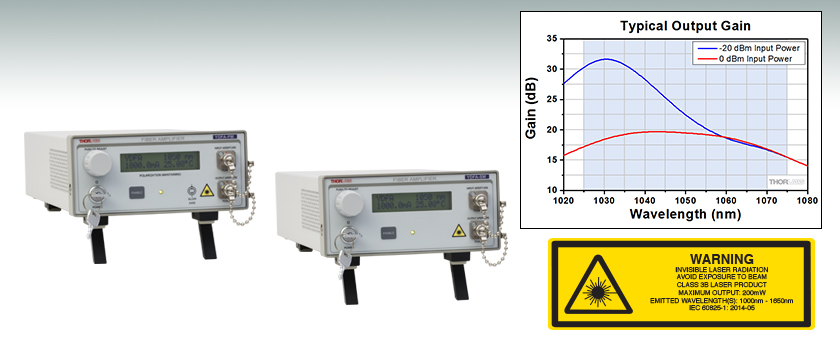
- Saturation Output Power of >20 dBm
- Broad 1025 - 1075 nm Operating Range
- Optimized for Ultrafast Pulse Amplification
- Simple, Turnkey Operation
YDFA100P
Polarization-Maintaining YDFA
YDFA100S
Single Mode YDFA

Please Wait
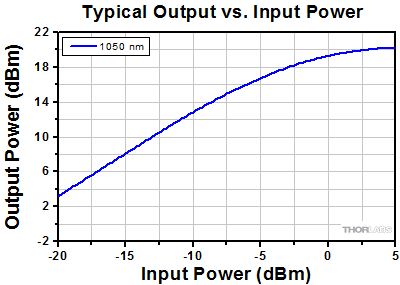
Click to Enlarge
このグラフは偏波保持型YDFAの入力パワーに対する出力パワーを示しています。すべての性能に関するグラフは「グラフ」タブでご覧いただけます。
特長
- 動作波長範囲: 1025~1075 nm
- 小信号利得:>22 dB、出力パワー(典型値):20 dBm(仕様の波長範囲における値については「グラフ」タブをご参照ください。)
- 超短パルス光およびCW光用のプリアンプとして使用可能
- シングルモード型、および偏波保持型の2タイプをご用意
- 前面パネルでの制御およびUSB経由でのリモート制御が可能
コア励起イッテルビウム添加ファイバ増幅器(YDFA)は、8 dB未満の低いNF(Noise Figure)で20 dBm(100 mW)の光パワー(典型値)を出力できます。 コンパクトですぐに使えるベンチトップ型パッケージに納められており、FC/APC入出力コネクタが付いています。フェムト秒パルスの用途に対応するため、分散が小さくなるように設計されています。 YDFAの入力側および出力側にはアイソレータが内蔵され、光源および増幅器への後方反射が抑制されています。増幅器の出力パワーおよび利得は、カスタマイズにより、大きくすることも可能です。ご希望があれば当社までご連絡ください。
当社では、シングルモード型と偏波保持型のYDFAをご用意しております。YDFA100Sは、利得の偏光依存性が0.3 dB未満のシングルモードファイバHI1060を使用しています。YDFA100Pは偏波保持型の増幅器で、入力側および出力側に内蔵されたアイソレータによりファイバPM980-XPのファスト軸に沿って偏光した光はブロックされます。そのため、YDFA100Pはファイバのスロー軸方向に偏光した入力信号に対して機能するように設計されています。増幅器から出力される光の偏光消光比は20 dB以上です。入力および出力ファイバのコネクターキーはファイバのスロー軸にアライメントされています。
YDFAは、前面パネルで励起電流を調節することで、利得や増幅器の光出力を変えることができます。また、USB 2.0コネクタ経由でシリアルコマンドを送信することで、励起電流のリモート制御も可能です。さらに、安全性を高めるために、背面パネルの2.5 mmモノラルジャックにインターロック回路を接続できるようになっています。
100~240 VAC、50~60 Hzに対応したユニバーサルな電源を内蔵しており、電圧の選択は不要です。また、日本国内対応の電源コードが付属します。
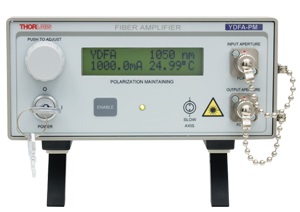
Click to Enlarge
YDFA100Pの前面パネル
YDFAの前面パネルには、デジタルディスプレイ、励起用半導体レーザの電流調整用回転式ノブ、キー・スイッチ(電源)、および増幅器のEnableスイッチとそれに連動する緑のLEDが配置されています。
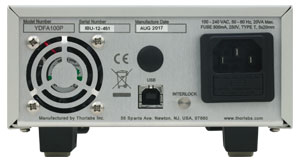
Click to Enlarge
YDFA100Pの背面パネル
YDFAの背面パネルには、リモート操作用のUSB B型コネクタと自作のインターロック回路を接続できる2.5 mmモノラルジャックがあります。
特別に記載のない限り、下記の全ての値は1050 nmのCW光を入力した場合の仕様です。
| Item # | YDFA100S | YDFA100P |
|---|---|---|
| Amplifier Specifications | ||
| Operating Wavelength Range | 1025 - 1075 nm | |
| Output Power (@ 3 dBm Input Power)a | 19 dBm (Min) 20 dBm (Typical) | |
| Small Signal Gain (@ -20 dBm Input Power)a | >22 dB | |
| Noise Figurea | <8 dB | |
| Output Power Stability (@ 3 dBm Input Power) | <±2% Over 24 Hours(After 15 Minute Warm-Up, for Ambient Temperature ±2 °C) | |
| Total Absolute Dispersion within Amplifier | <0.2 ps/nm | |
| Laser Class | 3B | |
| Fiber Specifications | ||
| Output Polarization | Random | Linear Aligned to Slow Axis |
| Polarization Extinction Ratio | N/A | >20 dB |
| Polarization-Dependent Gain | <0.3 dB | N/A |
| Return Loss at Input Port | >50 dB | |
| Input / Output Isolation | >20 dB | |
| Input / Output Fiber Type | HI1060 | PM980-XP |
| Input / Output Fiber Connectors | FC/APC Compatible, 2.0 mm Narrow Key | |
| Absolute Maximum Ratings | |
|---|---|
| Absolute Maximum Input Power | 10 dBm |
| Absolute Maximum Output Power | 23 dBm |
| Operating Temperature | 15 to 35 °C |
| Storage Temperature | 0 to 50 °C |
| General Specifications | |
|---|---|
| Input Voltage | 100 - 240 VAC, 50 - 60 Hz |
| Input Power | 20 VA (Max) |
| Fuse Rating | 500 mA |
| Fuse Type | IEC60127-2/III (250 VA, Slow Blow Type "T") |
| Dimensions (W x H x D) | 5.77" x 3.07" x 12.17" (146.5 mm x 77.9 mm x 309.1 mm) |
| Weight | 1.96 kg (4.32 lbs) |
| Connections and Controls | |
| Interface Control | Optical Encoder with Push Button |
| Enable Select | Keypad Switch Enable with LED Indicator |
| Power On | Key Switch |
| Fiber Connectors | FC/APC Compatible, 2.0 mm Narrow Key |
| Input Power Connector | IEC Connector |
| Interlock | 2.5 mm Mono Jack |
| Communications | |
| Communications Port | USB 2.0 Compatible |
| COM Connection | USB Type B Connector |
| Required Cable | USB Type A to Type B Cable (Replacement Item # USB-A-79) |
性能に関するグラフ
特別に記載がない限り、下の全ての性能グラフの値はCW入力、1000 mAの最大励起電流および25 °Cの励起レーザの温度(デフォルト値)の条件で得ています。性能は製品により異なる場合があります。データはYDFAシリーズの典型値であり、参考として提示しています。保証された仕様については「仕様」タブをご覧ください。
| Simulation Model Parameters | |||
|---|---|---|---|
| Input | |||
| Pulse Width | 50 fs | 100 fs | 200 fs |
| Pulse Energy | 26 pJ | ||
| Peak Power | >450 W | >240 W | >120 W |
| Output | |||
| Pulse Width | 3.8 ps | 3.3 ps | 2.7 ps |
| Peak Power | >300 W | >350 W | >400 W |
| Output with Compression | |||
| Pulse Width | 103 fs | 120 fs | 145 fs |
| Peak Power | >10 kW | >8 kW | >6 kW |
フェムト秒パルスの増幅
超短パルス光をYDFAによって増幅すると、分散効果によって広がります。この分散は、添加利得ファイバおよびその他のファイバの内部を光が伝播する際に自然に発生するもので、完全に除去することはできません。当社のYDFA増幅器では、分散および非線形性を最小限に抑えつつ増幅利得は最大となるように、利得ファイバの長さの最適化を行っています。増幅後にパルスを圧縮して入力パルスに近いパルス幅にすることもできます。YDFA100Pならびに YDFA100Sに使用されているファイバは分散特性と非線形性がほぼ同じのため、どちらもフェムト秒用途に適しています。
増幅器YDFA100Pを用いて3種類の入力パルスを増幅させたシミュレーション結果を下のグラフおよび右の表でご覧いただけます。入力光は1045 nm、26 pJのパルスで、そのパルス幅は50 fs、100 fsおよび200 fsです。 増幅器YDFAのシミュレーションでは、1045 nmでの利得を17.1 dBに設定し、測定した利得のスペクトル形状を用いて増幅パルスを算出しました。また、YDFAは増幅器の前後にそれぞれ1 mの偏波保持ファイバが付いているものとしてモデル化されています。さらに下の図には、1200 lines/mmの回折格子ペアを用いて増幅後のパルスを圧縮したシミュレーションの結果も示しています。表中のピークパワーを算出する際、回折格子の光学損失は無視しています。
増幅器YDFA100Pの実験的検証
この実験ではYDFA100Pによって増幅されたパルスの測定と出力パルスの数値シミュレーションの両方を行っています。100 MHzの発振器を用いて117 fsの入力パルスを発生させました。YDFA100Pを用いて平均出力2.6 mWのパルスを140 mWに増幅させ、外部のパルスコンプレッサで出力パルスを圧縮しました。入力および出力パルスの強度プロファイルは、周波数分解光ゲート法(FROG)を用いて測定しました。
下記の測定結果は、YDFAの小さな非線形性と3次分散の効果により、増幅されたパルスを元の幅に圧縮可能であることを示しています。上記のモデルを用いた入出力パルスのシミュレーション結果も実験データと併せて表示しており、実験結果と相対的に一致することを示しています。YDFA100Pならびに YDFA100Sに使用されているファイバは分散特性と非線形性がほぼ同じのため、どちらもフェムト秒用途に適しています。
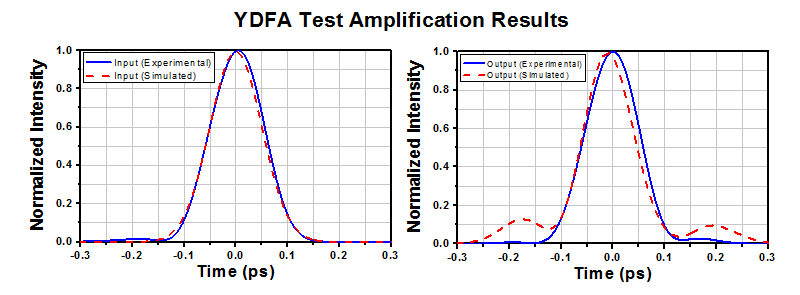
Click to Enlarge
増幅前のパルスと増幅後に圧縮されたパルスの実験結果とシミュレーション結果。実験データはLawrence Berkeley国立研究所のTong Zhou氏およびRussel Wilcox氏よりご提供いただきました。
増幅器の比較
EDFAやYDFAのようなファイバ増幅器は、一般的に半導体光増幅器(BOAやSOA)よりもフェムト秒パルスの増幅に適しています。これら2つのタイプの増幅器は、飽和エネルギ、利得飽和のダイナミックス、自由キャリアの寿命といった点で異なります。半導体増幅器の飽和エネルギは比較的小さく、数pJ程度です。そのため、半導体増幅器によって増幅できるパルスエネルギには限界があります。これに対し、ファイバ増幅器の飽和エネルギのレベルはµJ以上です。また、半導体増幅器の利得回復時間はキャリア寿命によって決まり、10 ps~100 ps程度です。一方、ファイバ増幅器のキャリア寿命は10 µs~1 msです。
1 MHz程度の繰返し周波数のモードロックフェムト秒レーザの場合を考えてみましょう。半導体増幅器の飽和エネルギよりも十分に低いパルスエネルギの場合、パルスをあまり歪ませることなく増幅できます。しかし、パルスエネルギが飽和エネルギを超えると、1つのパルスの継続時間中に増幅が飽和し、パルスの時間プロファイル内で利得差が発生してパルスの形状が歪んでしまいます。ファイバ増幅器は半導体増幅器よりも飽和エネルギが高いため、そのようなメカニズムに基づく利得飽和は発生しにくくなります。
半導体増幅器の利得回復時間(10 ps~100 ps)は繰返し周期よりも短いため、利得媒体はパルス列の次のパルスが半導体増幅器に到着する前に回復します。従って、上記と同じプロセスが各パルスで繰り返されます。ファイバ増幅器では、自由キャリア寿命(10 µs~1 ms)は、繰返し周期よりも大幅に長くなります。そのため、ファイバ増幅器はピークパワーではなくパルスの平均パワーに反応するとみなすことができます。
この他にフェムト秒パルスに関連する事項として、増幅器内における非線形過程の相違があります。ファイバ増幅器の非線形応答はほとんど瞬間的に発生しますが、半導体増幅器の非線形応答時間はキャリア寿命時間と関係して10 ps~100 psの時間スケールとなります。パルスエネルギが飽和エネルギを超えると、このpsレベルの応答はパルス歪みを引き起こす原因となります。
YDFA100SとYDFA100Pには下記が含まれます。
- ベンチトップ型パッケージに収められたイッテルビウム添加ファイバ増幅器
- 増幅器のEnableキー(2個)
- インターロック用短絡ピン
- 国内対応電源ケーブル
- ファイバーバルクヘッドおよびコネクタ用クリーナFBC250
- マニュアル
| Posted Comments: | |
Luis Ledezma
(posted 2024-04-17 08:51:07.877) Over the years we bought several YDFA100p, and have damaged the pump many, many times.
For instance, it is very easy to cause damage to the pump due to back-reflections. It would be extremely convenient if it was possible to pull both, input and output connectors, so the fiber tips can be properly inspected and cleaned. Right now this simple tasks requires opening the box and voiding Thorlabs warranty. The issues is similar if one wants to splice the YDFA to an external isolator.
Another improvement could be to add a WDM at the pump, so reflected power at the signal wavelength doesn't reach the pump. user
(posted 2021-05-27 17:04:52.043) Is there a rule of thumb for the maximum advisable pulse energy for longer input pulses (with nanosecond durations, for the sake of argument) operating at very low (single-shot to sub-kHz) repetition rates if you still keep the peak power below 500W? YLohia
(posted 2021-07-21 03:48:54.0) Thank you for contacting Thorlabs. Unfortunately, we do not have test data in this pulse regime and, therefore, we can only comment based on component specifications and general information on damage threshold of optical fibers: (a) fiber facet at the amplifier output is subject to damage threshold guidelines given on the website in the damage threshold tab here: https://www.thorlabs.com/newgrouppage9.cfm?objectgroup_id=949 (b) fiber isolator used inside the amplifier is specified to have a 500 W max peak power handling for nanosecond pulse widths. A factor to consider is that fiber amplifiers behave very differently in sub-kHz pulse rep rate regime than they do in few kHz-MHz regime. Please also note that the gain saturation dynamics of a YDFA occurs in msec time scale, hence, in a sub-kHz repletion rate regime, the amplifier gain saturation recovers in between pulses. This should be considered as it can have temporal impact on the pulse. There will be distortion to the pulses as a result of this effect, which is not specific to the YDFA100 device but rather fundamental to the fiber amplifiers. user
(posted 2021-05-03 16:58:57.643) Hi, can the YDFA100P work with a -25 dBm input? YLohia
(posted 2021-05-10 10:16:02.0) Hello, thank you for contacting Thorlabs. The YDFA100P will work at -25dBm input. You should expect ~23dB gain with 0 dBm output. A portion of this will be ASE (around ~2 dBm), which may need to be filtered out depending on the application requirements. SEUNGHO LEE
(posted 2021-05-04 11:22:05.02) I have question about the insertion max power. Can this device handle mid power laser about 200 mW ? So that can make 200mW to 300mW. YLohia
(posted 2021-05-04 11:17:00.0) The absolute max input power is rated at 10 dBm (10 mW) and the absolute max output power is 23 dBm (199.5 mW) so, unfortunately, this device cannot handle a 200 mW input and 300 mW output. user
(posted 2019-12-09 00:20:38.833) May I know whether YDFA100P work with signal at low repetition rates and ns pulse widths (eg., pulse width 3-5 ns; repetition rate: 10-100kHz. What is the minimum repetition rate on can operate for ns pulse amplification? What is the maximum input peak power for the amplifier at which gain of 22dB is available? YLohia
(posted 2019-12-12 03:51:57.0) Hello, thank you for contacting Thorlabs. Unfortunately, we do not have experimental data in this pulse regime. Any information given below is not guaranteed since we do not have the appropriate source to test. General guidelines related to this specific pulse condition are the following:
1. Upper-state lifetime of Yb is in ms range according to literature. Exact lifetime of this particular Yb-doped fiber is unknown as this depends on concentration and other factors in the host glass. Assuming the lifetime is around a ms, both 10 kHz and 100 kHz should be fast enough such that the amplifier gain saturation does not recover in between pulses. Hence, the amplifier would respond to the average power at the input.
2. With the argument in 1, the gain of the amplifier would saturate based on the input average power. If input average power is around -20 dBm (calculated based on pulse width, rep rate and peak power), the system should provide the 22 dB gain at 1050 nm.
3. One key parameter to watch for here is the output peak power. Our components are rated to max peak power of 500 W. A higher peak power can cause damage to the components, although this is somewhat dependent on pulse energy as well.
4. In this pulse regime, one should also be very careful with ASE noise coming out of the amplifier. The system produces 20-30 mW of ASE power with zero input. That means, when seeded with low input average powers (below ~ -15 dBm), a good portion of the output power will consist of ASE. The easiest way to minimize the impact of that is to use a narrow-band filter at the signal wavelength to remove the out-of-band ASE. For example, a 0.1 nm filter would easily pass the ns pulses through, but will eliminate > 99% of the ASE. Vasili Savitski
(posted 2019-11-25 13:59:26.367) Dear Sir/Madam,
I have a question about your Yb-doped amplifier (YDFA100P or -S). Would it be possible to use it for amplification of pulsed emission at 1064 nm with the pulse duration of 5 ns, repetition rate of 4 MHz and average power of 3mW? The emission linewidth is 0.15 nm. What sort of output powers may I expect in the output, if the amplifier is suitable for this task?
Thank you.
Vasili. llamb
(posted 2019-12-02 09:54:27.0) Hello Vasili, thank you for your feedback. Our Yb-doped amplifiers will indeed work well for the input you have described. The output average power will be around 20 dBm (100 mW) with this input. kkmion
(posted 2018-08-27 22:34:52.53) Can the output power up to 30dBm? YLohia
(posted 2018-08-29 10:57:44.0) Hello, the absolute maximum output power is 23 dBm so, unfortunately, it cannot output 30 dBm. |
 Products Home
Products Home









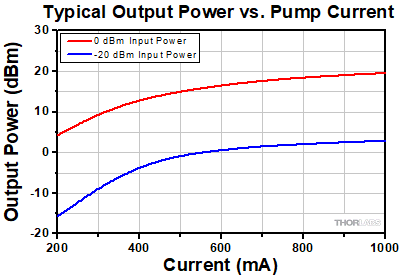
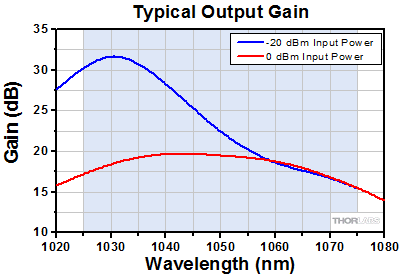
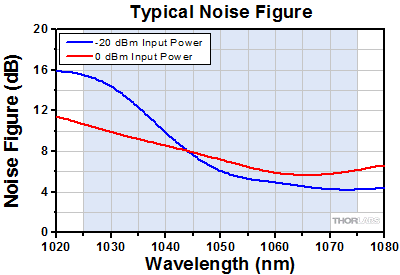
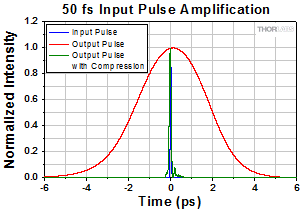
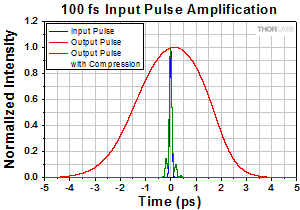
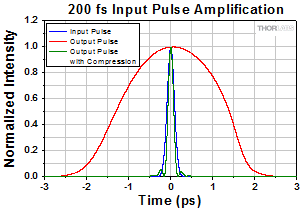

 イッテルビウム添加ファイバ増幅器(YDFA)
イッテルビウム添加ファイバ増幅器(YDFA)